New York City
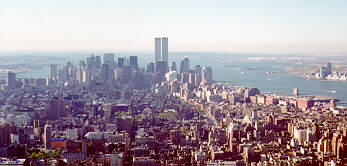
 New York City
New York City

New York City is made of five boroughs separated by various waterways. Brooklyn and Queens occupy the western portion of Long Island, while Staten Island and Manhattan are compeletely on their own land mass. Bronx, to the north, remains attached to the New York State mainland.
New York Discovery and Settlement
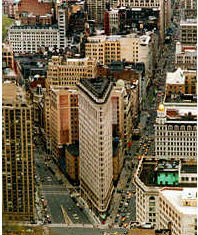 New York was briefly (1789-90) the U.S. capital and was state capital until 1797. By 1790 it was the largest U.S. city, and the opening (1825) of the ERIE CANAL, linking New York with the GREAT LAKES, led to even greater expansion.
New York was briefly (1789-90) the U.S. capital and was state capital until 1797. By 1790 it was the largest U.S. city, and the opening (1825) of the ERIE CANAL, linking New York with the GREAT LAKES, led to even greater expansion.
In 1898 a new charter was adopted, making the city Greater New York, a metropolis of five boroughs. Massive IMMIGRATION, mainly from Europe, swelled the city's population in the late 19th and early 20th cent. After World War II, many African Americans from the South, Puerto Ricans, and Latin Americans migrated to the city in search of jobs.
Population
City population: 7,420,166 (1998)
Bronx 1,195,599
Brooklyn 2,267,942
Manhattan 1,550,649
Queens 1,998,853
Staten Island 407,123
Metropolitan area: 8,643,437 (1998)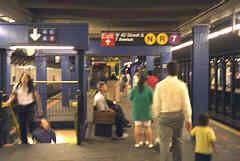
Size
New York City total area in square miles: 301
Area of Manhattan in square miles: 22.7
13.4 miles (21.5 km) long
2.3 miles (3.7 km) at widest point
.8 miles (1.3 km) at narrowest point
Climate
Average temperatures:
January 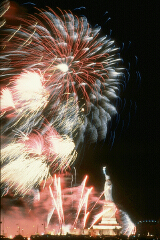 Low 26 degrees F, -3.33 degrees C
Low 26 degrees F, -3.33 degrees C
High 38 degrees F; 3.33 degrees C
July
Low 67 degrees F; 19.44 degrees C
High 84 degrees F; 28.89 degrees C
Average rainfall:
January 3.11 inches
July 3.67 inches
Average snowfall:
January 7 inches
July 0 inches
Things to see in New York
TIMES SQUARE
This 24-hour circus of towering billboards, hi-tech graphic displays, flashing lights, reeling numbered statistics, jam-packed intersections, and bewildered onlookers is the face of New York City, according to the rest of the world. Named for the old New York Times building at the intersection of 42nd Street and Seventh Avenue, Times Square is best known for it's New Year's Eve ball dropping tradition.
Though the tag-team work of Giuliani and Disney to earn the place a PG rating has rendered Times Square to ain't-what-it-used-to-be status,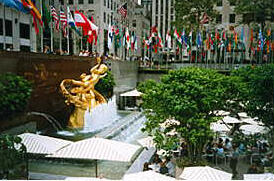 the cleaner, tourist-friendly square remains a popular destination for millions.
the cleaner, tourist-friendly square remains a popular destination for millions.
Today the neighborhood captures neither the pre-counterculture glitz of its glory days nor the perversely attractive smuttiness of its dog days-the million watt spectaculars, hookers, and heroin addicts have disappeared from sight, leaving towering billboards of corporate advertisers and jam packed double-decker buses.
ROCKEFELLER CENTER
A midtown complex of commercial buildings commissioned by John D. Rockefeller Jr. in 1929, Rockefeller Center is a masterpiece of art deco modern design.
Rockefeller's 21 acres of gardens, plazas, art, and architecture are most famous for some of its well-known residents: NBC Studios, the Rink at Rockefeller, Radio City Music Hall, the (now closed) Rainbow Room, and even the Fashion Caf�. The Rockefeller Center Promenade hosts such events as Rodin exhibits or International Flower Shows. The center is also the home of one of the most famous annual Christmas Tree lightings in the country.
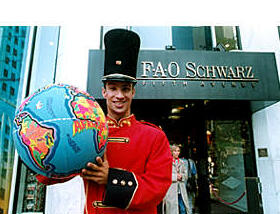 Beneath the complex, there's a large, underground shopping mall, but the prime attraction at Rockefeller is the NBC Studios tour. "Late Night with Conan O'Brien" and the "Rosie O'Donnell Show" are both taped on the premises, while the "Today Show"'s window-to-the-world studio allows a glimpse into the inner workings of network television.
Beneath the complex, there's a large, underground shopping mall, but the prime attraction at Rockefeller is the NBC Studios tour. "Late Night with Conan O'Brien" and the "Rosie O'Donnell Show" are both taped on the premises, while the "Today Show"'s window-to-the-world studio allows a glimpse into the inner workings of network television.
FAO SCHWARZ
However over-the-top, over-crowded, and over-priced, FAO Schwarz continues to be a top tourist destination, particularly with families and children-and for good reason. 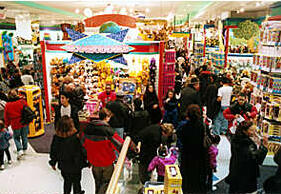 This store is a veritable playroom for kids of all ages. Beginning with a red-cheeked soldier greeting guests at the door, an ensemble cast of mechanized toys pulls you into a world of, well, more toys. From Babe the pig, to beanbuddies, plush-stuffed animals, and an amazing assortment of gadgets and geegaws to try out,FAO Schwarz has remained a distinctive toy emporium for over a century. Employees get into the act, demonstrating the newest playthings and pointing visitors toward elaborate monuments to the most popular toys of the season.
This store is a veritable playroom for kids of all ages. Beginning with a red-cheeked soldier greeting guests at the door, an ensemble cast of mechanized toys pulls you into a world of, well, more toys. From Babe the pig, to beanbuddies, plush-stuffed animals, and an amazing assortment of gadgets and geegaws to try out,FAO Schwarz has remained a distinctive toy emporium for over a century. Employees get into the act, demonstrating the newest playthings and pointing visitors toward elaborate monuments to the most popular toys of the season.
SOUTH STREET SEAPORT
 An historic trading port that dates back to the 1600s, the "Street of Ships," that was once one of the city's most vital commercial portals, has been reinvented for modern commercial use.
An historic trading port that dates back to the 1600s, the "Street of Ships," that was once one of the city's most vital commercial portals, has been reinvented for modern commercial use.
Where once warehouses handled the goods entering and leaving the city, produce and fish were sold at the Fulton Market, and the wharves teemed with ships, now stands a restored South Street Seaport that is home to over 120 shops, restaurants, and eateries.
Quaint cobblestone pedestrian-only 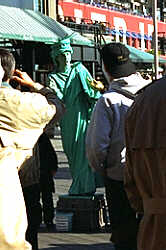 streets and scenic views of the Brooklyn Bridge give a welcome and peaceful respite from the grime of urban living. Since its restoration in the late 1960s, the South Street Seaport has gone through a period of intense growth, including the South Street Seaport Museum, the Pier 17 Pavillion, and the renovated Fulton Market Building, as well as many major retail stores.
streets and scenic views of the Brooklyn Bridge give a welcome and peaceful respite from the grime of urban living. Since its restoration in the late 1960s, the South Street Seaport has gone through a period of intense growth, including the South Street Seaport Museum, the Pier 17 Pavillion, and the renovated Fulton Market Building, as well as many major retail stores.
BROOKLYN BRIDGE
When it was completed in May 1883, the Brooklyn Bridge was the longest suspension bridge in the world. A composite effort by numerous architects and workers, the building of the bridge took many lives and many millions of dollars to complete. Though plagued by construction difficulties, the Brooklyn Bridge-with its unprecedented use of steel cabling suspension combined with limestone and granite arches-has since become a National Historic Civil Engineering Landmark.
Though plagued by construction difficulties, the Brooklyn Bridge-with its unprecedented use of steel cabling suspension combined with limestone and granite arches-has since become a National Historic Civil Engineering Landmark.
A symbol of American urbanization and industrialization, the Brooklyn Bridge is an immediately recognizable milestone in NYC history and culture. Walking across the bridge going toward Manhattan, pedestrians can look through the huge arches and soaring cables at the sun glinting against the skyscrapers and shimmering on the water. From Brooklyn's River Caf� and the Brooklyn Anchorage (the base of the arched bridge supports), there are superb views of downtown Manhattan-particularly at night when the skyline is awash in lights.
CENTRAL PARK
Central Park has been an attraction for tourists and residents alike since its opening in 1858. 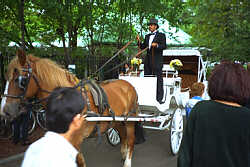
In case you didn't believe that a megalopolis like NYC actually had green space, we'll take you on a tour of the stately lawns, ponds, theaters, observatories, boathouse, and playgrounds sprinkled throughout the 843 acres of the United States' first landscaped public park. From horse and buggy rides and concerts at the bandshell, to boating on the lake, relaxing with a book on the grass, riding the merry-go-round, or taking a romantic stroll around the Bethesda Fountain, Central Park has something for everyone.
Looking west across the lake toward the twin towers of the coveted San Remo building, it seems surreal to have such a vast park beneath the towering buildings of the city, but this beautiful oasis certainly exists.
At Fifth Avenue and 34th Street stands one of New York City's most famous architectural fixtures-the Empire State Building. Once the world's tallest skyscraper, the 1,250-foot (102-story) building was completed in 1930. Atop the commercial space of the building sits a metal and glass "mooring mast" for dirigibles, adding approximately sixteen more stories of height to the building.
From the Art Deco interior of the building, visitors can look down upon the city from one of two observation decks. On the 86th floor is an outdoor deck that gives an ethereal feeling of floating far above the city. Further up on the 102nd floor, visitors can peer out across New York from a small, enclosed observation area. Views from either observation area dwarf the buildings below, giving an unusual perspective on NYC architecture.
There are 354 stairs to climb if you want a glimpse of the Statue of Liberty's riveted innards and the crowning view.
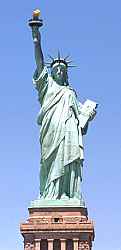 To see the Statue of Liberty you'll have to wait online for tickets in Battery Park, just outside of Castle Clinton. From there, board the ferry for the short cruise to Liberty Island. If the weather is nice, go outside for the best views of downtown Manhattan and the statue. Or, buy souvenirs onboard.
To see the Statue of Liberty you'll have to wait online for tickets in Battery Park, just outside of Castle Clinton. From there, board the ferry for the short cruise to Liberty Island. If the weather is nice, go outside for the best views of downtown Manhattan and the statue. Or, buy souvenirs onboard.
Once on Liberty Island, you can climb through the (airless) spiral stairway up to the top for a squished view out of the crown. Nevertheless, Lady Liberty offers visitors a unique vantage point from which to admire the buildings rising up in downtown Manhattan. Plus, the original "flame" of Lady Liberty's torch is on display in the basement of the structure.
WALL STREET
Originally the northern 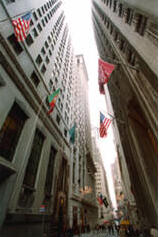 boundary of the New Amsterdam settlement, Wall Street has come to signify the financial universe in an age of global capitalism. Where once a wall was built to protect against possible attacks from the uncharted north, there now sits the American Stock Exchange, the World Trade Center Towers and Plaza, and countless other financial empires. Skyscrapers loom ominously over the narrow street that is home to the world's largest accumulation of gold and the whiz of billions of dollars electronically changing hands every second. Statues such as the bronze Merrill Lynch bull are tributes to the vast wealth of this thriving financial center. There are still remnants of the the old settlement,the old Trinity Church and graveyard juxtaposed against subway signs and turn-of-the-century architecture.
boundary of the New Amsterdam settlement, Wall Street has come to signify the financial universe in an age of global capitalism. Where once a wall was built to protect against possible attacks from the uncharted north, there now sits the American Stock Exchange, the World Trade Center Towers and Plaza, and countless other financial empires. Skyscrapers loom ominously over the narrow street that is home to the world's largest accumulation of gold and the whiz of billions of dollars electronically changing hands every second. Statues such as the bronze Merrill Lynch bull are tributes to the vast wealth of this thriving financial center. There are still remnants of the the old settlement,the old Trinity Church and graveyard juxtaposed against subway signs and turn-of-the-century architecture.
 Return to the Fridge door
Return to the Fridge door